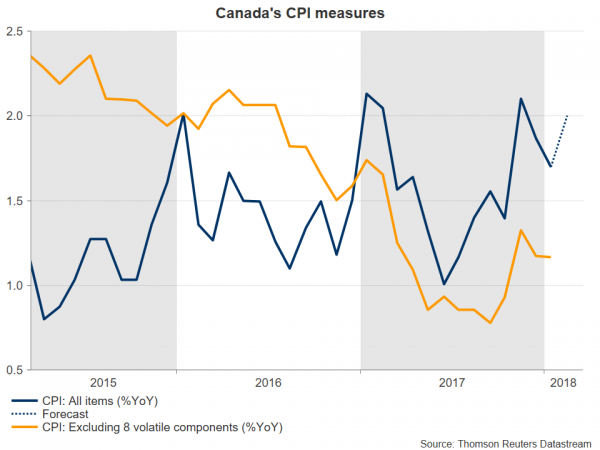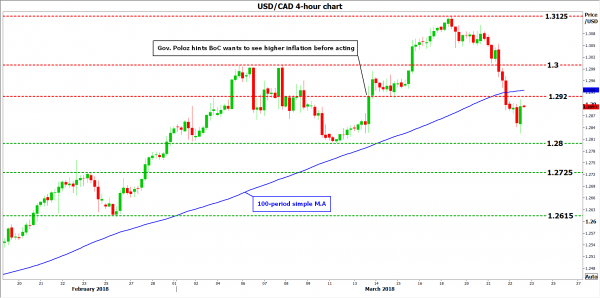Canada will see the release of its inflation and retail sales data on Friday at 1230 GMT, with forecasts pointing to an acceleration in price pressures and a sharp rebound in consumer spending. While such prints would be pleasant news for the Bank of Canada (BoC) and could benefit the loonie, the currency’s broader direction will also depend to a large degree on how the NAFTA talks progress in the coming weeks.
The BoC has gone to great lengths to appear as cautious as it can recently, even while raising interest rates three times since July. While strong economic growth and robust employment gains have encouraged the Bank to begin normalizing its policy, concerns over record-high household debt and the future of free trade agreements like NAFTA have remained a major source of uncertainty for policymakers. As for inflation, even though it has largely remained short of its 2% mark, the Bank has worked under the assumption it will pick up relatively soon. However, recent comments from Governor Poloz suggest policymakers are not particularly convinced this will actually occur soon, and instead prefer to see higher inflation materialize before raising rates more aggressively.
 The Bank’s cautious thinking puts all the more emphasis on the upcoming set of inflation and retail sales data. In February, the headline CPI rate is projected to have risen to 2.0% year-on-year from 1.7% previously, while no forecast is available for the core print. As for retail sales, they are anticipated to have risen by 1.1% in January on a monthly basis, after a 0.8% decline previously, while the core figure is also expected to have rebounded sharply. Taken together, such prints would probably be encouraging news for the BoC, as they could signify both that inflation is moving in the desired direction, and that consumer spending did not stall as much as December’s numbers would lead one to believe.
The Bank’s cautious thinking puts all the more emphasis on the upcoming set of inflation and retail sales data. In February, the headline CPI rate is projected to have risen to 2.0% year-on-year from 1.7% previously, while no forecast is available for the core print. As for retail sales, they are anticipated to have risen by 1.1% in January on a monthly basis, after a 0.8% decline previously, while the core figure is also expected to have rebounded sharply. Taken together, such prints would probably be encouraging news for the BoC, as they could signify both that inflation is moving in the desired direction, and that consumer spending did not stall as much as December’s numbers would lead one to believe.
At the time of writing, markets see a 60% probability that the BoC will raise rates again at its May policy meeting, according to Canada’s overnight index swaps. In case these data come in strong, especially on the inflation front, investors may price in a higher probability for a May hike and thereby, help the loonie to recover some of its recent losses. Dollar/loonie could fall back down for a test of the 1.2800 territory, identified by the lows of March 12, while steeper declines may aim for the 1.2725 zone, marked by the February 23 highs. A downside break of that area as well could open the way for the 1.2615 barrier, the February 26 low.
On the flip side, a disappointment in these data could diminish expectations for a near-term rate increase and thereby, bring the loonie under renewed selling interest. Dollar/loonie would likely surge and challenge the 1.2920 zone, which is the 50.0% Fibonacci retracement of the May-September 2017 pullback. If the bulls overcome that hurdle, resistance may be found near the psychological 1.3000 obstacle, while even further advances could bring the 1.3125 area into focus, the pair’s recent highs.
 As for which outcome is more probable, gauges of inflation were quite optimistic in February. Canada’s Markit manufacturing PMI for February showed that factory gate price inflation held close to its highest seen for seven years, supporting the forecast for an acceleration in consumer prices.
As for which outcome is more probable, gauges of inflation were quite optimistic in February. Canada’s Markit manufacturing PMI for February showed that factory gate price inflation held close to its highest seen for seven years, supporting the forecast for an acceleration in consumer prices.
In the bigger picture, besides speculation around the BoC, the loonie’s broader direction will also depend to a large extent on how the “protectionism theme” plays out and how the NAFTA negotiations progress. The next round of NAFTA talks is tentatively scheduled for mid-April, while the next BoC meeting is planned for the 18th of April. Unless there is substantial progress in the trade talks that alleviates some uncertainty by then, the loonie may find it difficult to rally even if the BoC strikes a hawkish tone.













